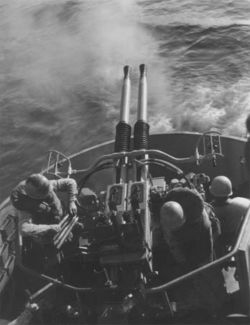40mm-56 caliber gun
| This article may be deleted soon. | ||
|---|---|---|
Due to technical limitations, this article uses an unusual title. It should be called 40mm/56 caliber gun.
The 40mm/56 caliber gun was a piece of anti-aircraft artillery (AAA) gun used on almost every major U.S. and U.K. warship of World War II. It was regarded as a vast improvement over the previous 1.1-inch antiaircraft weapon, and probably ranks as the most efficient close-in air defense weapon on any warship during WWII.
The gun came in two basic mountings, the smaller being a twin-barrelled version used mostly in destroyers, amphibious ships, and lighter craft. The larger quadruple mount, basically two twins side-by-side, was found primarily in carriers, battleships, and cruisers. The guns were recoil operated and used a monobloc barrel with a detachable breech ring, breech casing and automatic loader. The breech block was a vertical sliding type. Ammunition was held in clips of four rounds each. Each of the twin 40mm's fired 160 rounds per minute per barrel, with an approximate effective range of 4,000 yards. The guns were manned by seven men with ammunition passers added to the crew as required. The crew consisted of a gun captain, pointer, trainer, two first loaders and two second loaders. Ready service ammunition was held in racks welded to the "gun tub", a steel bulwark built around the gun to protect the crew. When ammunition in the ready service racks was used up, they would be refilled from below. HistoryThe gun was based on a very widely-used design of the Bofors Company of Sweden, first produced in 1936. Early designs were regarded as unsuitable for mass production and Navy use for many reasons, among them being the large amount of hand work required in manufacture and the fact that their air-cooled nature limited their ability to fire long bursts, which was a necessity in antiaircraft warfare. To minimize these problems, U.S. manufacturers made radical changes to the Swedish design, so the guns and mountings produced in the USA bore little resemblance their Swedish ancestors. The U.S. models were water-cooled, and were built to English measurement units rather than the original metric, and incorporated hydraulic drives rather than the original friction drives. The Chrysler Corporation redesigned ten components to suit mass production techniques and saved some 7,500,000 pounds (340,200 kg) of material and 1,896,750 man hours during a year's production, as well as freeing up 30 machine tools for the production of other components. The guns' ammunition was also redesigned to make it safer for shipboard use and interchangeable with that of all U.S. and U.K. manufacturers. The development of the Mark 51 director system gave the U.S. weapons greatly improved accuracy. For example, half of all Japanese aircraft shot down between 1 October 1944 and 1 February 1945 were credited to the Bofors/Mark 51 combination. The first U.S. Navy guns were completed in 1942. The first shipboard installations were on the gunnery-training ship (ex-battleship) USS Wyoming (AG-17) and the destroyer USS Coghlan (DD-606) in July, 1942. A massive U.S. production program soon began, with over 39,000 guns being built by the end of the war. Even so, the demand was not fully met until well into 1944. Late in World War II, the U.S. Navy started replacing 20 mm Oerlikon guns with the Bofors 40 mm guns, as the smaller weapon was found to be ineffective against Japanese Kamikazes. But even the Bofors was determined to be inadequate against suicide attacks, so the 40mm's were in turn replaced during the late 1940s and 1950s with the new rapid fire 3"/50 designs. References |
||
- Articles for deletion October
- CZ Live
- Military Workgroup
- United States Navy Subgroup
- Royal Navy Subgroup
- Pacific War Subgroup
- Articles written in American English
- Advanced Articles written in American English
- All Content
- Military Content
- Military tag
- United States Navy tag
- Royal Navy tag
- Pacific War tag
- Reviewed Passed if Improved
